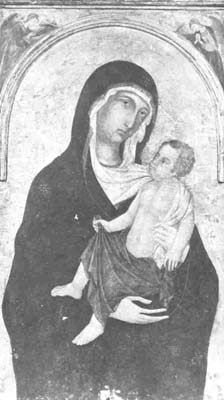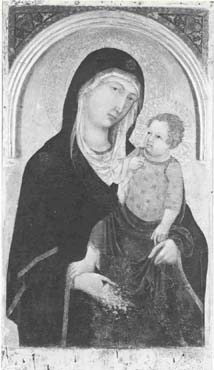
Annual Bulletin 5, 1981-1982
Home
Français
Introduction
History
Annual Index
Author &
Subject
Credits
Contact



Ugolino di
Nerio: Saint Anne and the Virgin
by Laurence B. Kanter
Pages 1
| 2 | 3
| 4
| 5
| 6
| 7
More interesting perhaps than what visual
sources Ugolino may have been able to draw upon is the question of who
might have commissioned such an image from him. The cult of Saint Anne
was just at this time beginning to expand in the West, and was especially,
though not exclusively, associated with two monastic orders: the Franciscans
and the Carmelites. The Franciscans were the foremost exponents of the
then controversial doctrine of the Immaculate Conception, and pictures
of Saint Anne and the Virgin are thought to have served almost as broadsheets
for the promulgation of this belief in the Virgin's purity from the moment
that her mother conceived. (8) Ugolino had repeatedly demonstrated contacts
with the Franciscans. At least seven altarpieces and three smaller devotional
panels by him were painted for churches of that order. The Carmelites trace
their particular devotion to Saint Anne to the Legend that Anne's mother,
Hysmeria, was vouchsafed a vision of her holy offspring while visiting
the hermits on Mount Carmel, the ancestors claimed by the modern Carmelites. (9)
While the Franciscans and Carmelites were the foremost sponsors of the cult of Saint Anne, it cannot be assumed that the Ottawa panel was necessarily
painted for a church of either order. It is equally possible that the altarpiece
of which it formed the central panel - for such appears to have been its
function - was painted to decorate the altar of a chapel containing a relic
of Saint Anne; intended, in other words, as an object of devotion without
polemic undertones, as is believed to be the case with the famous statue
and window at Chartres. (10) Private devotions to Saint Anne also proliferated
in the thirteenth and fourteenth centuries, (11) so that one cannot be too
narrow in tracing possible sources for Ugolino's commission.
The date of the Ottawa Saint Anne is
problematic. Ugolino's career is generally thought to have overlapped Duccio's and to have ended not too long after the latter's death. Few writers
consider even his last works to be later than about 1325.
Yet a number of his paintings reveal the marked influence of an artist
presumably of a younger generation, Pietro Lorenzetti, and none does more
so than the Ottawa Saint Anne. Though the basic cartoon of the infant
Virgin and her mother may recall Duccio's Perugia Madonna, it is
realized with none of the hieratic frontality and planarity of that picture.
The softened roundness of these figures, their darker and more varied palette,
the relative freedom of their movement in space, and the intimacy and liveliness
of details in their portrayal are all dependent on the example of Pietro
Lorenzetti in such works as the Madonna from the Carmelite altarpiece
of 1329 or the Montichiello or Castiglione d'Orcia Madonnas. But
if these influences are real, which is to say, if this is neither a case
of parallel but independent development nor of Ugolino's preceding the
innovations of Pietro (neither of which is at all likely), then notions
of the progress of Ugolino's career are in need of reconsideration and
total revision.
None of Ugolino's paintings is dated or exactly
datable and none can be firmly documented. His numerous extant works do,
however, reveal a coherent pattern of development from which a relative
chronology may be deduced. It is logical to suppose, and is in fact generally
assumed, that his earliest pictures are to be identified among those of
his works most faithfully linked to Duccio, such as the Madonna and
Child from the Tadini-Boninsegni collection (fig. 3), now in the Meridionale at the Palazzo Pitti, Florence, part of the Contini-Bonacossi
bequest. (12) The composition of this picture recalls Duccio's Stoclet
Madonna,
(13)
where the Virgin's hands and draperies are almost identically disposed
and the Child similarly reaches up to clutch the Virgin's veil with his
right hand. The conception of the figures is less ambitious than in other paintings by Ugolino. They are arranged as closely as possible parallel
to the picture plane with minimal attempts at foreshortening, so that for
example the tops of both of the Child's feet are visible. The draperies
are painted with great delicacy, but fall in simple folds with no unnecessary
ripples or creases. An early date for the Tadini Madonna is also implied by the simple arched top of the panel and the engraved design
against a cross-hatched ground which fills the haloes. This technique of
decoration was largely supplanted in Sienese painting after about 1320
by the use of tooled punches, while ogival and trilobe profiles replaced,
though never totally, the rounded arches of earlier panels.
Similar to the Tadini Madonna in its
strong Ducciesque character is another panel with incised decoration in
its haloes and framed by a simple arch moulding (fig. 4). This is the centre panel from the heptaptych acquired in 1962 by the Sterling and Francine
Clark Art Institute at Williamstown, Massachusetts. (14) In this picture
the Child has turned decidedly to one side and rests his foot on his mother's arm. The Virgin's hands
are more convincingly foreshortened than in the Tadini Madonna, and
the draperies of both figures have been enlivened with pockets of shadow
and decorative folds. The figures throughout the Clark altarpiece - one
of the largest, most beautifully painted, and most beautifully preserved
of the early fourteenth century - are taller and of more elongated proportions than are those in Ugolino's probable earlier pictures.
This is also true of the figures in Polyptych
39 in the Pinacoteca Nazionale at Siena. (15) The five panels comprising this
altarpiece have been severely damaged, but among them the Madonna and Child
in the centre (fig. 5) and the Saint Francis at the extreme right can
still be recognized as autograph works. The design of the central panel is
based on that in Ducio's Polyptych 28 in Sena, (16) while the execution of the
figures is unmistakably the same as in the Clark and Tadini Madonnas,
or in the Madonna at the Chateau Langeais, Touraine. (17) The curve of
the child's foot resting on His mother's wrist in Polyptych 39, or the deeper
folds in the robe at his waist, indicate a slightly later date, as does the
new technique of decorating haloes with tooled punches against a stippled
ground. The rosette and lozenge punches first encountered here recur in all
of Ugolino's later works, many of which also include the three-petalled leaf
punch which grows along a vine in the haloes of the Virgin or Saint Francis
and which seems to sprout from the inner ring of the Child's nimbus.
Next Page | Ugolino's characters
1
| 2 | 3
| 4
| 5
| 6
| 7
Annual Index | Author & Subject | Credits | Contact
This digital collection
was produced under contract to Canada's Digital Collections program,
Industry Canada.
"Digital
Collections Program, Copyright
© National Gallery of
Canada 2001"